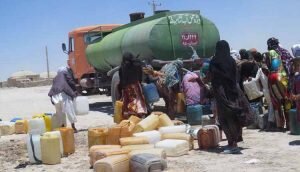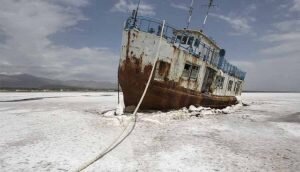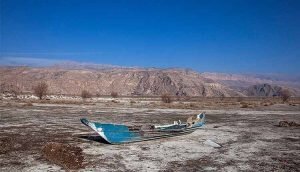Iran-HRM – Looming Disaster, Iran Drought Crisis
Introduction
Experiencing its harshest drought in the last 50 years, Iran is facing serious problems in attaining its required water.
Nearly half of the country’s population will soon face water shortages and approximately 97 percent is experiencing drought to some degree, according to the Iran Meteorological Organization. Rights groups say drought has driven many people out of their homes.
Head of the Department of Environment, Eassa Kalantari, said, “If we fail to resolve the drought crisis, 50 million Iranians will have to leave the country in the next 25 years; an immigration that’s going to have dreadful consequences, in such a way that we may no longer have a country called Iran.” (The state-run Aftab website, September 18, 2016)
Although the climate change and warming of the region have been an important part of the water crisis in Iran but the regime’s mismanagement and corruption over the past few decades have been far too instrumental in causing today’s drought and the drying up of lakes and rivers all across the country.
With the average precipitation per decade dropping from 250 to 217 millimeters, solving the water problem should logically be the most important priority for the regime.
The bitter irony, however, is that the regime is directly responsible for the drought crisis. The Iranian regime and its organs including the Revolutionary Guard Corps are the main parties involved in building non-expert dams and digging deep water wells, which essentially cause such challenges.
One of the most visible examples of drought in Iran is in Isfahan, central Iran, home to a once mighty river, the Zayandeh Roud, or the River of Life, that used to cut through the historic center. Now completely dried up, Zayandeh Roud river has turned into a symbol of the water crisis brought about by mismanagement and overuse rather than drought. The riverbed now resembles a vast, gravelly beach, a dead stretch of sunbaked land that winds through the heart of Isfahan.
In the summer of 2018, Iran will walk on the edge of a severe drought. According to forecasts and statistics, the country will experience one of the hottest summers of recent decades. Droughts currently threaten the lives of more than 37 million Iranians; a threat that authorities have not taken seriously. These statistics and warnings have not only been announced by experts and environmental activists, rather, officials at the Ministry of Energy have also confessed to this issue.
Irreparable effects of drought on the lives of farmers and other people
Generally, people’s perception of a drought is dry and cracked land without greenery. This is while drought can have severe consequences, including economic, agricultural, employment and cultural issues and can also lead to a social crisis.
Thanks to the regimes ecological policies, the phenomenon has overshadowed the lives of million Iranians.
Health of the residents of Khuzestan Province is jeopardized by the outbreak of hepatitis A and cholera due to severe drought.
The head of the Ahwaz Jundishapur University of Medical Sciences warned about the effects of water shortages and droughts on the spread of diseases, especially waterborne diseases.
“The monitoring of drinking water and food security are among the duties of the University of Medical Sciences, and in light of current conditions, we will probably face problems,” Dr. Iraj Nazari said.
“Currently, there are reports of hepatitis A in Ahwaz and several other cities in the province of Khuzestan. Also, cholera, with its peak in the first 9 months of the year, can be aggravated by water shortages,” he added referring to waterborne diseases. (The state-run ISNA state-run News Agency – April 4, 2018)
More than 80% of the children in South Khorasan’s villages suffer from skin problems due to water shortage. Mohammad Bagher Ebadi, MP from Birjand, cited that more than 80% of the kids in the villages of South Khorasan Province (east of Iran) suffer from skin problems, and added: “I have seen them from close, time and again during the last three months. Unfortunately, due to water shortage the people there don’t have enough hygiene and cannot have a bath correctly. … About 480 villages at South Khorasan province suffer from water shortage and they receive water by tankers. Many of the watercourses there have dried up.” (The state-run ILNA News Agency- May 24, 2018)
Meanwhile erosion of Iran’s wetlands had led to more sand storms in drier regions causing health problems.
The Head of the Public Relations Office of Zabol University of Medical Sciences said that 78 residents of the Sistan and Baluchestan region went to hospitals and medical centers as a result of sand storms in the province…
“Unfortunately, due to the drying up of our wetlands and sandstorms, the people in the region go to hospitals and medical centers for various health issues, mainly respiratory problems and eye diseases,” Hamid Reza Bazi added. (The state-run Mehr News Agency – April 1, 2018)
Exacerbated by mismanagement, drought has also impacted the lives of millions of people in parched areas, analysts say. It has disrupted people’s income particularly the farmers who accuse local politicians of allowing water to be diverted from their areas in return for bribes. Farmers say that over the years, the government has deprived them of their share of the water sources of the region.
According to the Deputy Director of the Isfahan Regional Water and Waste Management Department, drought conditions and the sharp decline of water resources in Isfahan Province have been unprecedented in the last 50 years, and the amount of water stored in the Zayandeh Roud River dam is 144 million cubic meters, which is only about 10 percent of the volume of the tank. (The state-run IRNA news agency, April 4, 2018)
The situation for the farmers is the same in other cities. The Governor of Nimruz, a city in Sistan and Baluchestan Province said that 12,000 hectares of this city’s autumn crops were completely destroyed due to drought and water shortages. (The state-run ISNA News Agency- April 7, 2018)
Amir Jafari-Qoli, member of the Committee for the Protection of Waters in the province of Chahar Mahaal and Bakhtiari warned, “With the construction of the Behesht-Abad tunnel, four cities (Ardel, Kiar, Boroudjen, Sharh-e-Kurd) will be transformed into desert.”
According to the environmental experts of the Kohgiluyeh and Boyerahmad, so far, 40,000 hectares of land in the south of the province have been exposed to desertification due to unauthorized drilling of 1,000 wells.
Cities and villages without water
343 water sources for villages in Sistan & Baluchistan have completely dried up,” said The Director of Villages’ Water and Sewage in Sistan and Baluchistan Province. Abdol-Ahad Rigi added: “1,232 villages have water problems. Delivering water with tankers requires special credits.”

Regi also said that 3,024 villages lack any kind of water delivery: “Potable water for these villages is provided by tankers… Yet again 348 water delivery systems for the villages of Sistan & Baluchistan have become inactive,” he mentioned. (The state-run ISNA News Agency- May 5, 2018)
Reza Arbabi, the Director General of the Crisis Management Department of the province, said that about 100% of the area of the province suffered from moderate to very severe drought.
“Currently, the province’s dams are only 40% full, and the remaining 60 percent is empty. To compensate for the losses, 70 billion tomans (about 19,000 dollars) were approved last year, but nothing has been allocated so far. This year we also had 30 billion tomans (about 8,000 dollars) in damage in Iranshahr and the surrounding cities, but so far no payment has been made,” he added. (The state-run Tasnim News Agency – February 17, 2018)
A member of the Iranian regime’s parliament from the city of Iranshahr in southeastern Iran has recently said, “3,000 villages of Sistan & Baluchistan Province lack any drinking water network”.
“1,200 villages in this province have water delivered with trucks,” said Mohammad Naeim Amini-Fard in an interview with the state ISNA news agency.
In northern Iran, due to lack of adequate resources, trucks deliver drinking water to 110 villages of Golestan Province, according to the official IRNA news agency quoting the director of Village Water & Sewage Systems Department. The population of these 110 villages sits at 44,849 people.
Bushkan, Kalameh, and Ahrom-e Tangeh are some of the towns in Bushehr that face the severest droughts and have been struggling with it for years. The wells that used to have water at 20 meters in the past 10 years, no longer yield water at 120 meters.
Due to loss of vegetation, livestock feed on dates. Farmers suffer from severe economic problems due to the loss of agricultural land and are struggling with livelihood issues. Lack of agricultural production has led to the migration of indigenous peoples to other parts of the country, to the extent that in villages in the Ahrom region, what used to be a village of more than 1,000 families, has now decreased to less than 100 families in the past 10 years. The migration rate has also caused various problems for immigrants and their hosts in different areas. (The state-run Mehr News Agency – April 12, 2018)
Parched wetlands, dried up lakes and rivers
Systematic mismanagement has led to drying up of 90% of Iran’s wetlands.
A member of the Majlis Environment Fraction said that the country’s water situation was critical. “Many rivers including Urmia Lake, and Zayandeh Roud have dried up and are on the verge of extinction,” Jonathan Bet Kolia said.
He cited the condition of Urmia Lake adding that “if the lake completely dries up and becomes extinct, around 14 provinces would be destroyed.”

“Due to the salt in that region, if there is a storm or severe rain, the whole region will be destroyed,” he added. “Of course some methods have been put forth to revive Urmia Lake including creating channels and bringing water from the Caspian Sea and other oceans, or channeling other rivers to the lake, but in practice no steps have been taken to put these solutions into effect and even if steps have been taken, they have not been tangible,” he added. “Only 10% of the wetlands have not dried up as yet, but if plans are not made to preserve them, these remaining wetlands will surely vanish,” the member of the Majlis Environment Faction said. (The official website of the Majlis, March 20, 2018)
Masoud Bagherzadeh Karimi, Director of the Environment Organization’s Wetland Ecosystems, said 90% of the Salahieh and Allahabad wetlands in southern Tehran had dried up. “The drying of these wetlands has become a source of dust for Tehran. This could be a major threat for Tehran and aggravate Tehran’s pollution problem,” he said. (The state-run ILNA News Agency – Feb. 3, 2018)
The lakes in the southern Fars Province have turned into salt fields which in turn can pose an environmental threat for the whole province.
Environmental expert Ali Akbar Kazemeini called the status of lakes in Fars Province “critical”, adding that the lakes have completely dried up.
The International Parishan Lake has also dried up leaving a small pond only for marine life.

Maharlu Lake contains only a small patch of sewage water coming from the city of Shiraz. Bakhtegan Lake, the second largest lake in Iran, is also in critical condition due to consecutive years of drought. No efforts have been made to revive the lake. (The state-run Mehr News Agency, April 17, 2018)
Zahra Jensi, deputy secretary of the environmental network of Gilan Province, pointed to the extremely terrible condition of Anzali wetland and said, “Unfortunately, it has been many years that the deepest sections of Anzali wetland measured only one meter, while this year these have reached less than half a meter. (The state-run Asr Iran Website- June 6, 2018)
Internationally recognized as one of the largest homes to migrating birds and fish in Iran, the Anzali Wetland is now sharing the fate of 60 other wetlands across the country that are on the verge of complete extinction due to wrong policies adopted by the ruling mullahs’ regime.
The Director General of the Social and Cultural Affairs of Golestan Governorate expressed concern over the state of international wetlands in Golestan Province. “In the last few weeks of the last (Persian) year, we visited the two wetlands of Alagol and Almagol and our field observations indicated that the wetlands in this province were drying up,” he said. Environment researcher and expert Ramezan Ali Ghaemi said that two thirds of the Gomeishan wetland had dried up and described it as being in a critical state. “The main reason for this is the nonstandard canalization of the Gomeishan wetland which was approved by the Environmental Organization in previous years,” he said.
“In less than a decade, many licenses have been issued for the development of aquaculture in the region, and two large canals (input and output) have been built. Even the remaining water of the output canals are streaming into the wetlands and with the decrease of the water in the Caspian Sea, the canals act like drains and quickly erode the lagoons,” the university professor added. (The state-run Mehr News Agency – Apr. 3, 2018)
Pishin Dam in Sarbaz Township, south of Sistan & Baluchistan Province dried up due to draught and decrease in the amount of rain.
The dam was built with the capacity of 175 million cubic meters to accumulate the seasonal rain, preventing floods and reviving agricultural lands of Bahokalat Dashtyari.
The Deputy for Planning and Construction Affairs of Sarbaz stated, “Right now the amount of water is less than 25 million m3, 18 million m3 of which are unusable.”
“Sarbaz Township is facing many problems, having no water and draught. So far, there has been irreversible damage to different sections,” he said. (The state-run IRNA News Agency- May 9, 2018)
The Managing Director of the Lorestan Regional Water Company said that the Madian Roud River was dying. The Madian River is used for irrigating the famous fig groves in the Zivdar region in Pol-e Dokhtar. “Although in the past 10 years, no permit has been issued by the regional water company for using the water of Madian River, unfortunately, since 2011 until now, the area of the fig groves has grown about twice as large without authorization and this has made the irrigation of the older groves extremely difficult,” Dr. Reza Mirzaie said. “The state of the river is very disturbing and it is predicted that in June this year its irrigational properties would reach zero percent and that it would completely dry up,” he added. (The state-run ISNA News Agency- Apr. 1, 2018)
A crisis in the making
Iran drought crisis could be hindered by proper water management. However, as the country is moving quickly towards a drought crisis, not only the regime has failed to take any effective measure to stop or even slow down the trend, it has further deteriorated the conditions by plundering the country’s water resources in return for large profits.
 Shabtabnews In this dark night, I have lost my way – Arise from a corner, oh you the star of guidance.
Shabtabnews In this dark night, I have lost my way – Arise from a corner, oh you the star of guidance.


